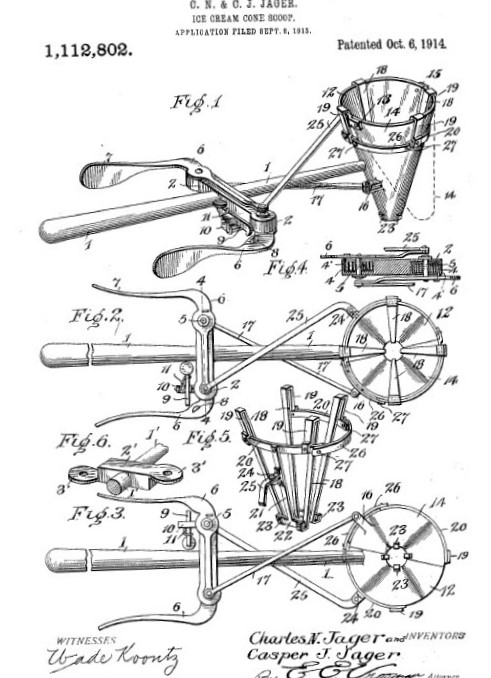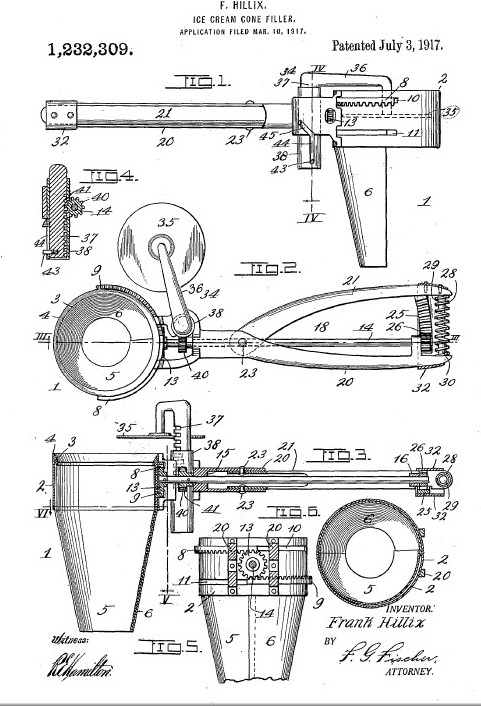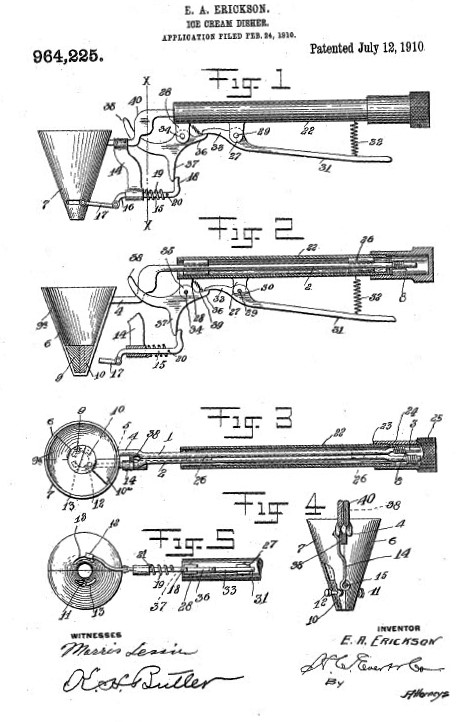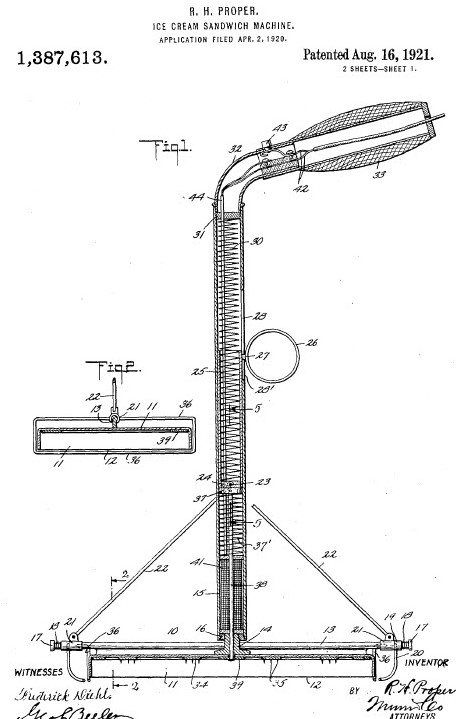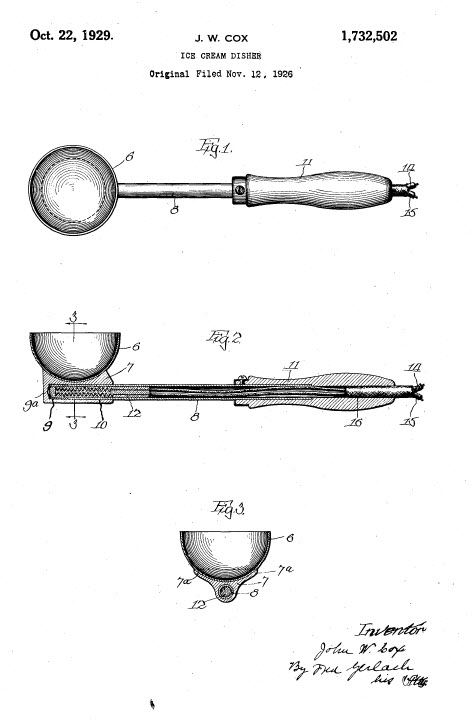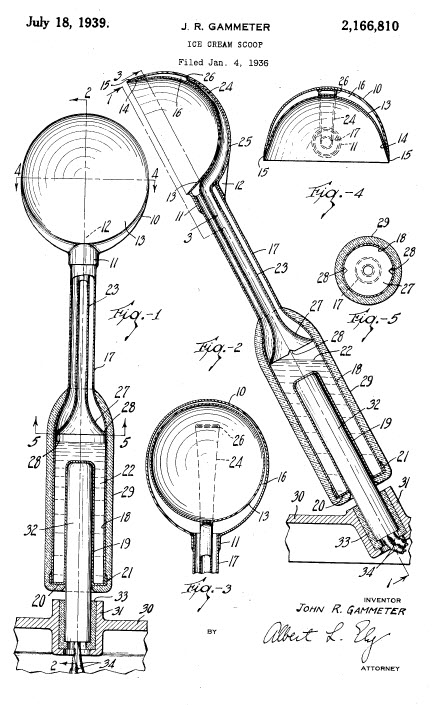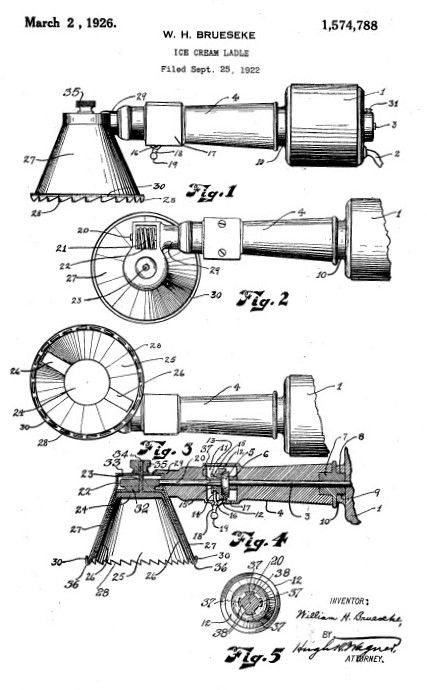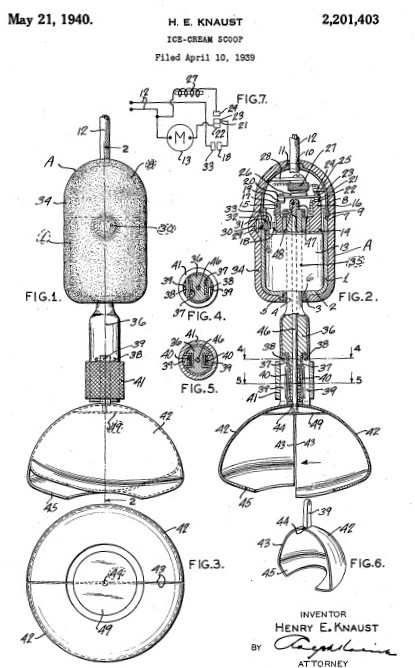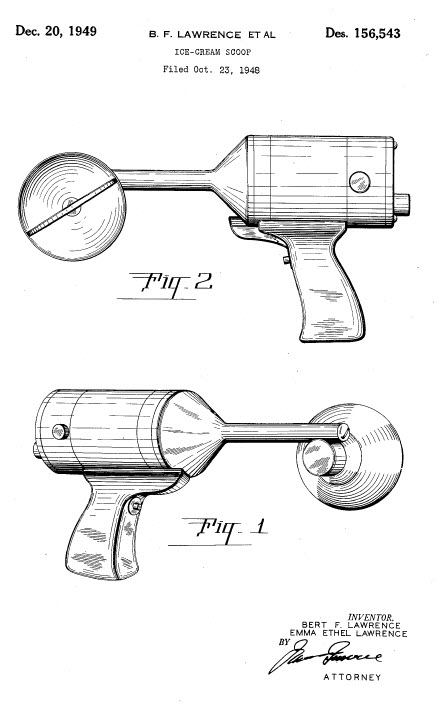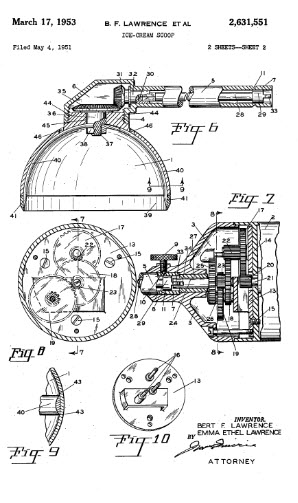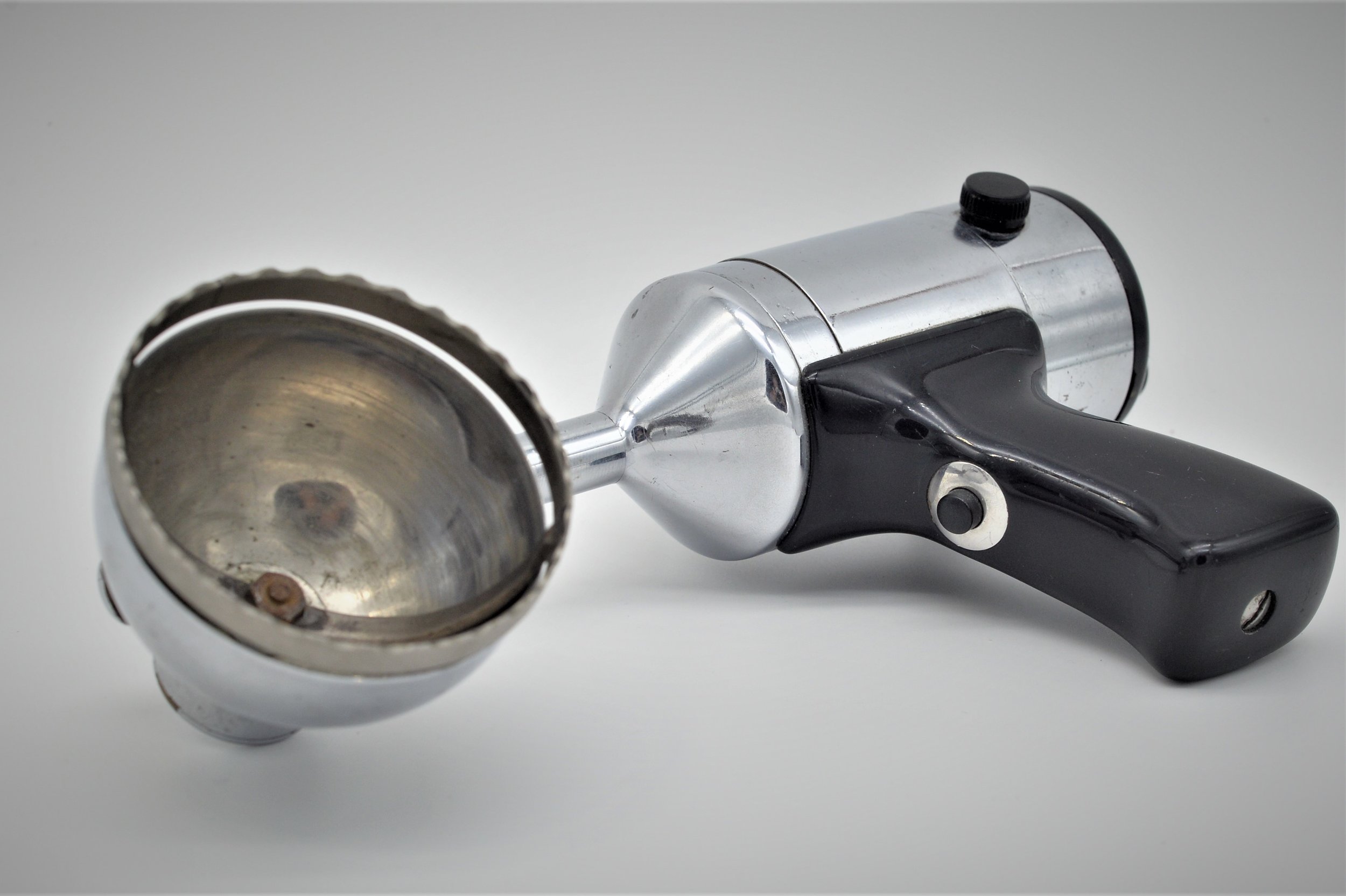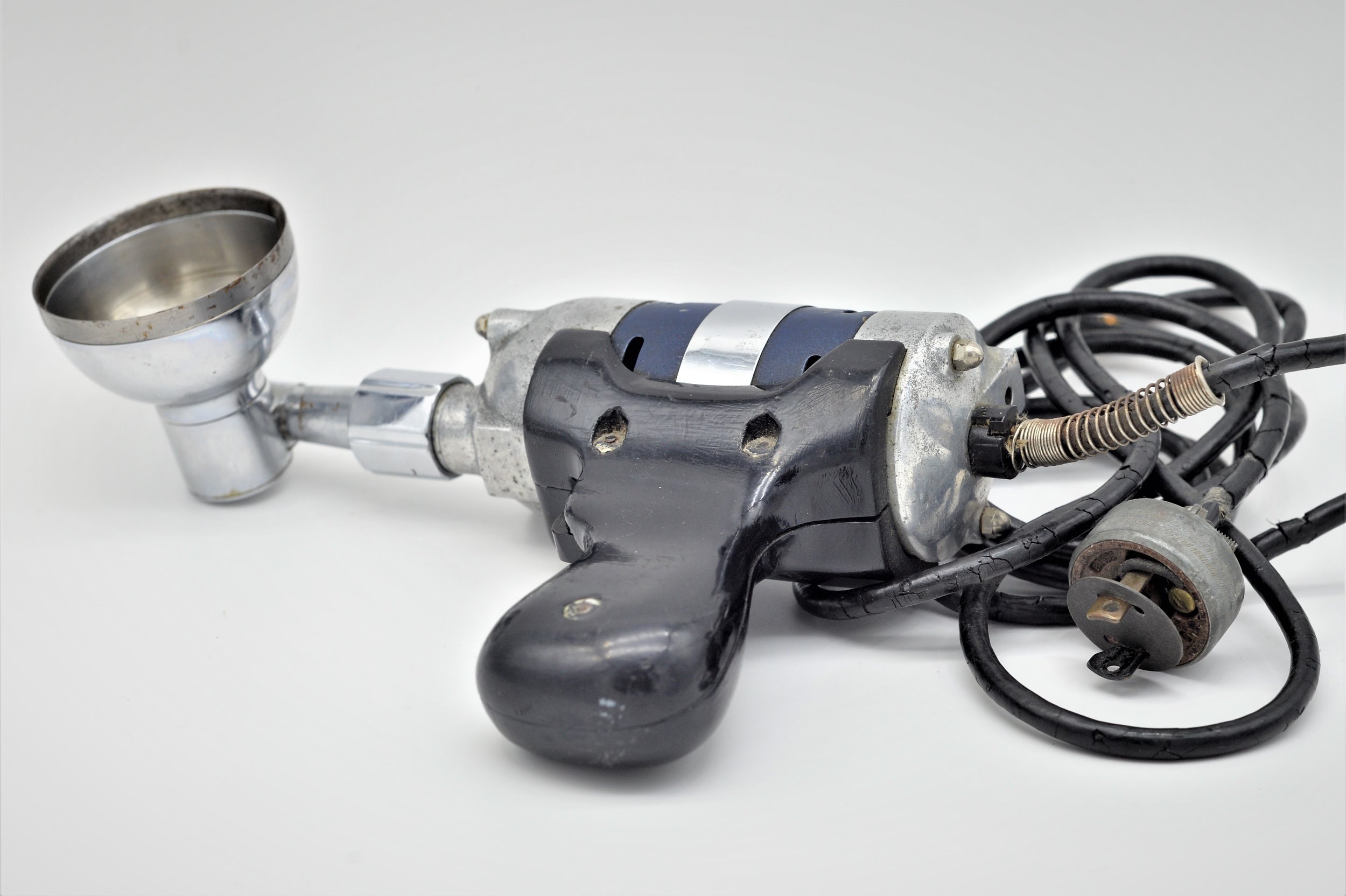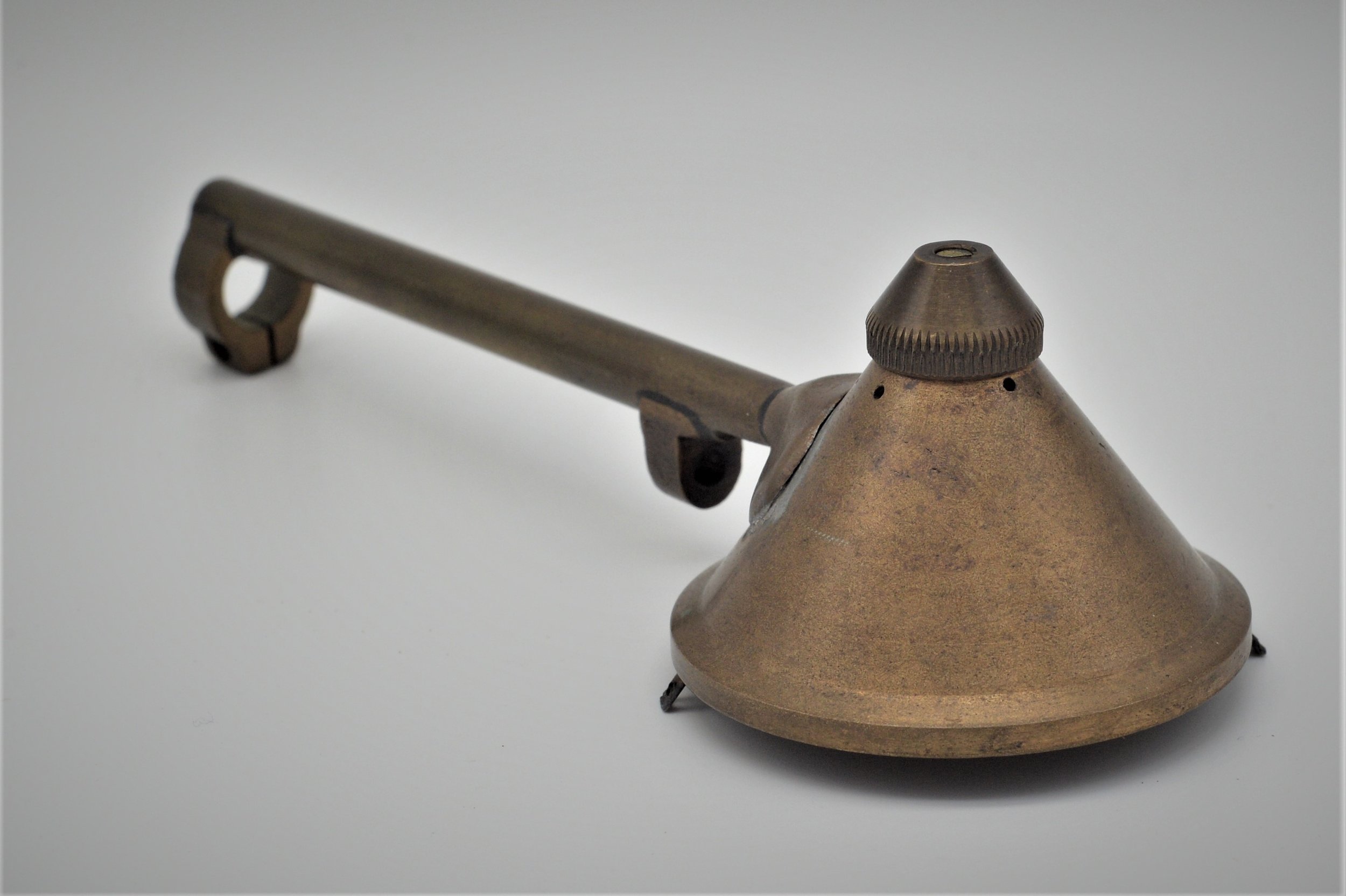Electric Ice Scream Scoops
Since the first ice cream scoop was developed by Clewell and Clad in 1878, hundreds of designs have attempted to improve on this simple task of measuring and molding a single serving of ice cream. From the first basic apparatus which required a two-handed operation to complete the task to a myriad of devices that called upon nearly all of the know laws of mechanical advantage. If there is a way to transfer the strength and dexterity of the human hand into a device by way of levers, gears, fulcrums, etc., it probably can be found in the design of an ice cream scoop. The thought process for this endeavor seems to have no boundaries. Many patent drawings depict methodologies similar to the Rube Goldberg machines known to be intentionally and unnecessarily complex. I imagine many of these odd designs did not make it to the manufacturing floor and remain as concepts only.
For me, the ingenuity of these inventors and the devices they produced are the attraction for collecting ice cream scoops.
This blog is about some of the attempts to incorporate electrical apparatus into the designs for ice cream scoops. The obvious and more common use for electrical power in these devices would be to warm the area where the ice cream meets the bowl of the scoop. This would allow the scooping and the discharging of the serving to be less strenuous. This method does work and can be found even in modern devices. These modern devices might utilize batteries to provide the power although some still use a standard cord and plug.
In my experience and especially with older models, a problem with heated bowls is that they do not regulate the heat well. There seems to be a very fine line between enough heat to be worthwhile and too much heat that leaves you with a hard-to-handle serving swimming around in the bowl of your scoop. Another big issue with electrifying ice cream scoops was that you could not submerge the device for cleaning and there would have had to be safety concerns with the older models.
The earliest patent that I could find for a scoop that utilized the thermal characteristics of electrical current was actually for an ice cream sandwich application. A cutter area on the device would be heated to facilitate a precise cut needed for filling an edible shell with a slab of ice cream. I find this particularly ingenious because the electrical current was utilized precisely and on a relatively complex device. You might imagine a more crude application for this early attempt to use electrical power in an ice cream scoop. Remember this was 1920 and I believe that this was the first, or nearly the first, ice cream scoop to utilize electrical power. I have included the patent descriptions along with the drawings. I have not seen any examples of this device. It may have been a failure or was just too difficult to manufacture on a practical and or safe basis. I may not have seen one of these because it does not look like a scoop and I would not have noticed had I seen one. What a find it would be!
The much more common utilization of electrical power in a scoop was just to heat the bowl. As I stated, earlier this approach has been utilized many times by several manufacturers. I do not believe that even with all of these years of utilization and development of this type of scoop they are widely used today.
More interestingly, the adaption of electro-mechanical designs for ice cream scoops took place not long after the aforementioned devices. A patent was awarded in 1926 for one such device. This too was the first of its kind that I can find. Curiously the patent was applied for in 1922 but not awarded until 1926. I can’t imagine why it took four years to appreciate that this was unique. As with all of the designs to follow the rotational motion of the device utilized an electrical motor to replace the human hand, albeit the human hand was still needed to flip the switch.
Of particular interest are the patents awarded to Bert Lawrence and his wife Emma Lawrence. Between 1946 and 1953 they were awarded five patents for electrical ice cream scoops. The couple went to the expense of obtaining patents in both the USA and Canada, creating detailed drawings, and promoting these devices. To the best of my knowledge, none of these were commercially introduced.
The following article that chronicles the history of the Lawrence family and the Whiz Dip electric scoop was written by Wayne Smith, author of (Ice Cream Dippers). Wayne graciously provided this information to help us with this look at electric ice cream scoops.
Whiz Dip Ice Cream Scoop
Inventors
Bert F. Lawrence and Ethel E. Lawrence
Bert Fowler Lawrence was born on Nov. 13, 1885 in Burlington. Kansas. By 1900 he was living on a farm in West Butte, Oregon with his parents Samuel and Sarah and brothers. His father died in 1907 and the family moved to the Portland, Oregon area. He graduated high school and by 1920, owned a farm in Garden Grove, Oregon for at least the next decade.
Ethyle E. Reynolds was born in Missouri about June of 1892. Her father, Robert, was a printer in Kansas City, MO. By 1930 she had experienced an unsuccessful marriage and was divorced. Ethyle E. Temple was her married name. At the time, Ethel, as she was also called, was renting a room in Kansas City and was working as a cashier at a theater.
Ethel’s roommate in Kansas City was Fern A. Lawrence. Fern had an unmarried uncle, Bert, in Oregon. She quite possibly was the matchmaker who introduced them both. Bert and Ethel must have been a perfect match because on Sept. 27, 1932 they were married in Vancouver, Washington just across the river from Portland.
Marriage has a way of changing lives. Within a few years of their marriage, lifelong farmer Bert and his new wife Ethel were in the restaurant business. In 1940 they were partners, running a lunch counter in Gresham, Oregon right near the entrance to the beautiful Columbia River Gorge.
Running a business serving food and ice cream sometimes encounters problems needing solutions. Serving hard ice cream may have been a problem. Bert and Ethel thought they had a solution….invent an ice cream scoop that would do it almost effortlessly….run by electricity.
On Jan. 9, 1945 they filed for a patent for their novel idea of an electric ice cream disher. The patent #2,412,050 was issued on Dec. 3, 1946 listing both Bert and Ethel as the inventors.
Before the first patent was even issued, they applied for a second patent with improvements to their first scoop. The patent application was filed on Feb. 27, 1946 and was granted on Feb. 6, 1951 as patent #2,540,397.
With two patents already issued, they changed the design of their first patent and filed for a Design Patent on Oct. 23, 1948. This design had a much heavier duty handle grip. The patent for this design change was issued on Dec. 20, 1949 as Design Patent #156,543.
Always looking for a way to improve their ice cream scoop invention they applied for yet another patent based on their earlier designs. This patent was filed on July 15, 1949 and was issued on Oct. 16, 1951 as patent #2,571,729. The cost of all of these patent applications with their drawings, paperwork, models and fees must have been considerable.
Bert and Ethel’s final attempt to design their idea of a perfect ice cream scoop was filed with the patent office on May 4, 1951. This design was novel in that the scooping end could be switched to accommodate either a right or left hand server. The end could also be detached to convert to a scraper or beater. The drawing specifications were done by Erwood, Inc. of Chicago in 1952. The patent was issued on Mar. 17, 1953 as patent #2,631,551. Weighing in at over 3 pounds, it may have been the heaviest ice cream scoop ever invented.
Around the time that the patent was granted in 1953 the Lawrence’s had moved back to his hometown, Burlington, Kansas and were marketing their invention as the “Whiz Dip”. They were featured on Topeka radio station WIBW personality Homer Cunningham’s “Coffee Time” show. Their catchy advertising promised “’Whiz Dip’ Dooms Dipping Drudgery”.
Despite all their costly efforts and work devoted to their novel and certainly unique electric ice cream scoop, none have ever appeared on the secondary market. Quite possibly, none were ever sold at all. All that remains now are the prototypes, patent records, drawings and marketing materials of one of the most unique ice cream scoops ever invented!
Wayne Smith 2019
Marketing
Lawrence Prototype 1
Lawrence Prototype 2
Lawrence Prototype 3

